 Effect of landscape design on depth perception in classical Chinese gardens: A quantitative analysis using virtual reality simulation
Effect of landscape design on depth perception in classical Chinese gardens: A quantitative analysis using virtual reality simulation |
| <Frontiers in Psychology, Nov. 2022> |
|
Haipeng Zhu, Zongchao Gu, Ryuzo Ohno and Yuhang Kong
|
|
|
It is common for visitors to have rich and varied experiences in the limited space of a classical Chinese garden. This leads to the sense that the garden’s
scale is much larger than it really is. A main reason for this perceptual bias is the gardener’s manipulation of visual information. Most studies have discussed
this phenomenon in terms of qualitative description with fragmented perspectives taken from static points, without considering ambient visual
information or continuously changing observation points. A general question arises, then, on why depth perception can vary from one observation point
to another along a garden path. To better understand the spatial experience in classical Chinese gardens, this study focused on variations in perceived
depth among different observation points and aimed to identify influential visual information through psychophysical experimentation. As stimuli for the
experiment, panoramic photos of Liu garden were taken from three positions at Lvyin Pavilion. Considering the effects of pictorial visual cues on depth
perception, the photos were processed to create 18 kinds of stimuli (six image treatments * three positions). Two tasks were presented to the participants. In
Task 1, 71 participants were asked to rate the depth value of the garden using the magnitude estimation method in a cave automatic virtual environment
(CAVE). Statistical analysis of Task 1 revealed that depth values differed significantly among different viewpoints. In Task 2, participants were asked to
compare 18 stimuli and 3D images presented on three connected monitors and to judge the depth of the garden using the adjustment method. The
results of Task 2 again showed that depth values differed significantly among different viewpoints. In both tasks, ambient information (i.e., the perspective of
interior space) significantly influenced depth perception.
Paper → PDF file
|
|
 Effect of Wall Texture on Perceptual Spaciousness of Indoor Space
Effect of Wall Texture on Perceptual Spaciousness of Indoor Space |
| <Int. J. Environ. Res. Public Health 2020, 17(11), 4177; https://doi.org/10.3390/ijerph17114177, June 2020 > |
|
Chong Wang, Wei Lu, Ryuzo Ohno and Zongchao Gu
|
|
|
As the main place of people’s daily activities, indoor space (its size, shape, colors, material and textures, and so on) has important physical,
emotional and health-based implications on people’s behavior and quality of life. Material texture is an integral part of architectural environment perception and quality
evaluation, but the effect of material texture on perceptual spaciousness lacks the support of experimental data. This research examined the effects between different wall
textures on the observer’s perception of spaciousness in indoor space, the influence of wall texture changes in different room sizes, and how the associational meaning of
texture affects the degree of influence of wall texture on the spaciousness of indoor space. By using VR technology and the magnitude estimation (ME) analysis method, the
authors found that the effect of wall texture on perceptual spaciousness varies depending on the wall material, and the textural effect is affected by room size. The perception
of spaciousness is influenced by the observer’s associational meaning of material texture, and the influence of associational meaning of material texture varies contingent on
the room size. In relatively small rooms, the objective aspect (such as hardness, surface reflectivity, texture direction and texture depth) of the wall texture has a significant
impact on perceived space. In contrast, the effects of subjective aspects (such as affinity and ecology) become more pronounced in relatively larger rooms. This research makes up
for the lack of material texture research in perceptual spaciousness, and provides a new way for the designer to choose materials for the design of a spatial scale.
.
Full paper ⇒ Online
|
|
 Phenomenal Awareness of the Surrounding Space: An Ecological Perspective
Phenomenal Awareness of the Surrounding Space: An Ecological Perspective |
| <Cognitive Studies: Bulletin of the Japanese Cognitive Science Society,
Vol. 15, No. 1, March, 2008 > |
|
Makoto Inagami, Ryuzo Ohno and Reiko Tsujiuchi
|
|
|
This study investigates the extent to which humans are aware of the space surrounding their bodies during daily locomotion.
To capture this awareness in its natural state, our experiment adopted an indirect method that uses feelings of oppression and release caused by
the surrounding environment. Participants continuously rated their feelings by turning a dial while walking along an outdoor route.
The physical environment along this route was described in terms of the visible areas of buildings, trees, ground, and sky.
Each area was measured from four different widths of view angles ranging from a limited view in front to a full 360° view.
Analysis of the relationship between the ratings and measurements reveals that the feelings have the highest correlation with the 360° measurements.
This result supports our hypothesis that humans are aware not only of the limited visual field but also of the entire surrounding space,
including the space behind their bodies. Based on this finding, we discuss the traditional concept of spatial perception from an ecological perspective.
Paper → PDF file
|
|
 Effects
of emerging scenes from the occluding edges on visual attention and
evaluation of the landscape Effects
of emerging scenes from the occluding edges on visual attention and
evaluation of the landscape |
|
<J. Architect. Plann. Environ. Eng. Architectural Institute of Japan, (556), June 2002 pp.197-203>
Ryuzo Ohno, Azusa Udagawa, Masashi Soeda
<Presented at EDRA conference in Vancouver, May 2005>
|
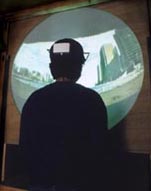
Full paper → PDF file |
|
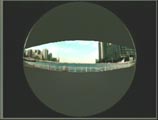 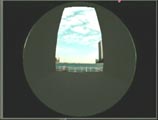 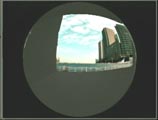 |
| The present study examines the influence of the design of exit space on visual attention of a person who is leaving a
building and on his/her impression of the outside scene. An experiment using visual simulation was conducted to test the assumption that the visitor's
impression of an unfamiliar scene is affected by spatial layout of the exit space of a building. Twelve movies, four kinds of CG animations of opening overlaid on three photographs of different outdoor scenes, were projected on orthographic projection screen, which enabled a subject to observe a wide angle image. After viewing each movie lasting 12 seconds, each of thirty-six subjects, who wore an eye-mark recorder, was asked to rate the overall impression of the scene using seven bipolar adjective pairs. As a result, some aspects of the subject's impressions were found to vary according to the way the scene opened up as one moved through the space. The analysis of the subjects' eye movement revealed that subjects tended to attend the area in the scene coming into sight from the occluding edges, where subjects could find more information than other areas. Combination of these results suggests that subjects' overall impression is affected by the order of appearance of partial scenes (components) in the sight, and the eye movements, which tend to follow the occluding edges that move rapidly toward the periphery. |
|
 Perception of the Sense of Enclosure in Interior Spaces with Variations in Transparent and Opaque Surfaces
Perception of the Sense of Enclosure in Interior Spaces with Variations in Transparent and Opaque Surfaces
|
|
<Environment-Behavior Research on the Pacific Rim: Proceedings of PaPER
98, in printing, the 11th International Conference on People and Physical
Environment Research, pp. 35-42, 2001>
|
|
Ryuzo Ohno, Keiichiro Hara
|
 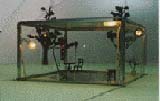
|
- Contemporary buildings often feature enclosed spaces with large areas
of window glazing. This study was made to assess the effect on the occupants
"sense of enclosure" of different positions and amounts of
transparent and opaque surfaces for both daytime and nighttime conditions.
Subjects wearing a head-mounted display device permitting a high degree of
head movement virtually "visited" a scale model space, under day
and night conditions, whose enclosing surfaces were systematically varied
with either transparent or opaque surfaces.
- Analyses of the results indicated that :
- 1) Judgments of "degree of enclosure" clearly differentiated
between spaces with transparent ceiling and those with an opaque ceiling.
- 2) Subjects feel less enclosed in a space with two adjacent transparent
walls than with other arrangements of the same transparent and opaque walls.
- 3) Larger variation of "degree of enclosure" was noted in case
that a transparent ceiling turns to an opaque ceiling than a transparent
wall turns to an opaque wall in the daytime, but the opposite was true in
the nighttime.
- 4) The variance of "degree of enclosure" between transparent and
opaque surfaces was larger in the daytime than in the nighttime.
|
Full paper → PDF file
 Hypothetical Model of Environmental Perception: Ambient vision and layout of surfaces in the environment
Hypothetical Model of Environmental Perception: Ambient vision and layout of surfaces in the environment |
|
<Book Chapter: in Wapner et al eds., Theoretical Perspectives in Environment-Behavior
Research, Kluwer Academic/ Plenum Publishers, pp.149-156, 2000>
Ryuzo Ohno
|
|
The nature and role of ambient vision in environmental perception, as opposed to focal vision, is discussed based on recent findings in physiology and psychology, and a method which describes ambient visual information is proposed and tested by applying it to assess outdoor spaces of housing neighborhoods. The information obtained by ambient vision is hypothetically defined as a statistical measure of an array of visual surfaces which surround an observer. The visual surfaces in the environment were divided into basic units (components) on the basis of their ゛affordance", such as surfaces of pavement, earth, grass, trees, building and sky.
A personal computer program was developed to measure the solid angles of visible area of the components and the volume of visible space around a given point in a proposed environment. Empirical studies, in which subjects rated sequential landscapes of different housing neighborhoods, revealed that the global impression, or feelings of a place can be well explained by some of the measures obtained by the program. |
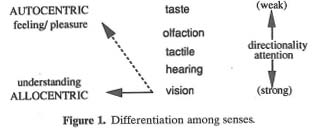 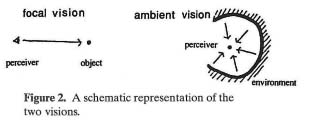 |
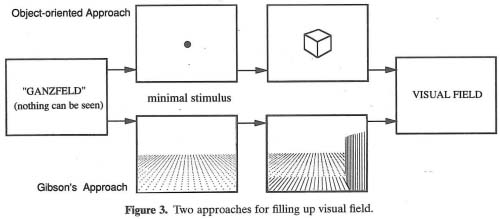 |
Full paper → PDF file
 Ambient Vision of the Environmental Perception: Describing Ambient Visual Information
Ambient Vision of the Environmental Perception: Describing Ambient Visual Information |
|
<Proceedings of 22nd EDRA Conference, Environmental Design Research association, pp. 237-245, Mar. 1991>
Ryuzo Ohno
|
|
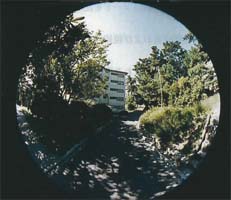 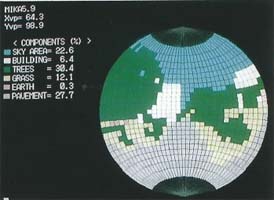
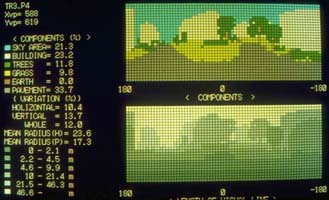
|
The nature and role of ambient vision in environmental perception, as opposed to focal vision, is discussed based on recent findings in physiology and psychology, and a method which describes ambient visual information is proposed and tested by applying it to assess outdoor spaces of housing neighborhoods. The information obtained by ambient vision is hypothetically defined as a statistical measure of an array of visual surfaces which surround an observer. The visual surfaces in the environment were divided into basic units (components) on the basis of their ゛affordance", such as surfaces of pavement, earth, grass, trees, building and sky.
A personal computer program was developed to measure the solid angles of visible area of the components and the volume of visible space around a given point in a proposed environment. Empirical studies, in which subjects rated sequential landscapes of different housing neighborhoods, revealed that the global impression, or feelings of a place can be well explained by some of the measures obtained by the program. |
Full paper → PDF file
 Notion of Duality in the Visual System and its Implication for Environmental Design
Notion of Duality in the Visual System and its Implication for Environmental Design |
|
<Proceedings of the Second US-Japanl Seminar, pp. 24-26, Oct. 1985>
Ryuzo Ohno
|
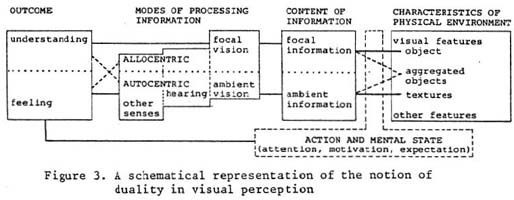 |
Judging from the growing number of papers presented at the annual conference
of the Architectural Institute of Japan, architects and architectural researchers’
interest in environmental psychology is steadily increasing. However, many
of these papers, particularly dealing with environmental perception, lack
solid theoretical background. It may be partly because researchers can
utilize an available "package" of existing psychological research
tools with computer programs for analyses. For instance, multidimensional,
or multifunctional analysis, which is now a very popular technique, is
applied to "digest" numerous characteristics of an physical environment
in order to explain human responses to it. In doing this, a number of elements
in the environment are often arbitrarily chosen without a good theoretical
framework. Thus, no clear conclusions can be obtained.
It may be useful to propose a model of environmental perception which can
suggest what aspect of the environment is relevant to a certain kind of
behavior. In other words, if we know what kinds of stimulus information
in the environment are processed and utilized by human observer in a certain
situation and in a certain behavior, then architects can design an environment
quite effectively for a certain purpose. For instance, when considering
the visibility and legibility of emergency exits in large underground shopping
malls in the city center of Tokyo, research based on such a model may suggest
how to locate signs and design other surrounding features.
This paper, reviews recent findings in physiology and psychology which suggest there are two different mechanisms in processing visual information, namely focal vision and ambient vision, and discusses the implication of this notion for environmental design and research. |
Full paper → PDF file
|
 TEXTURE PERCEPTION VERSUS OBJECT PERCEPTION IN THE ENVIRONMEN
TEXTURE PERCEPTION VERSUS OBJECT PERCEPTION IN THE ENVIRONMEN
|
|
< Proceedings 8th International Conference of the IAPS, p. 4, Jul. 1984.>
|
|
Ryuzo OHNO, Kiyotaka Komuro
|
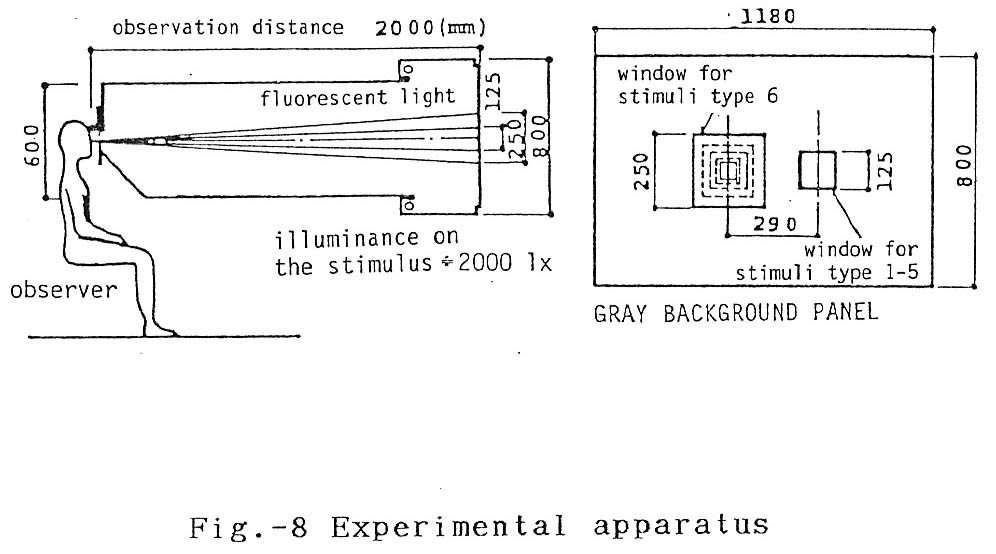 . .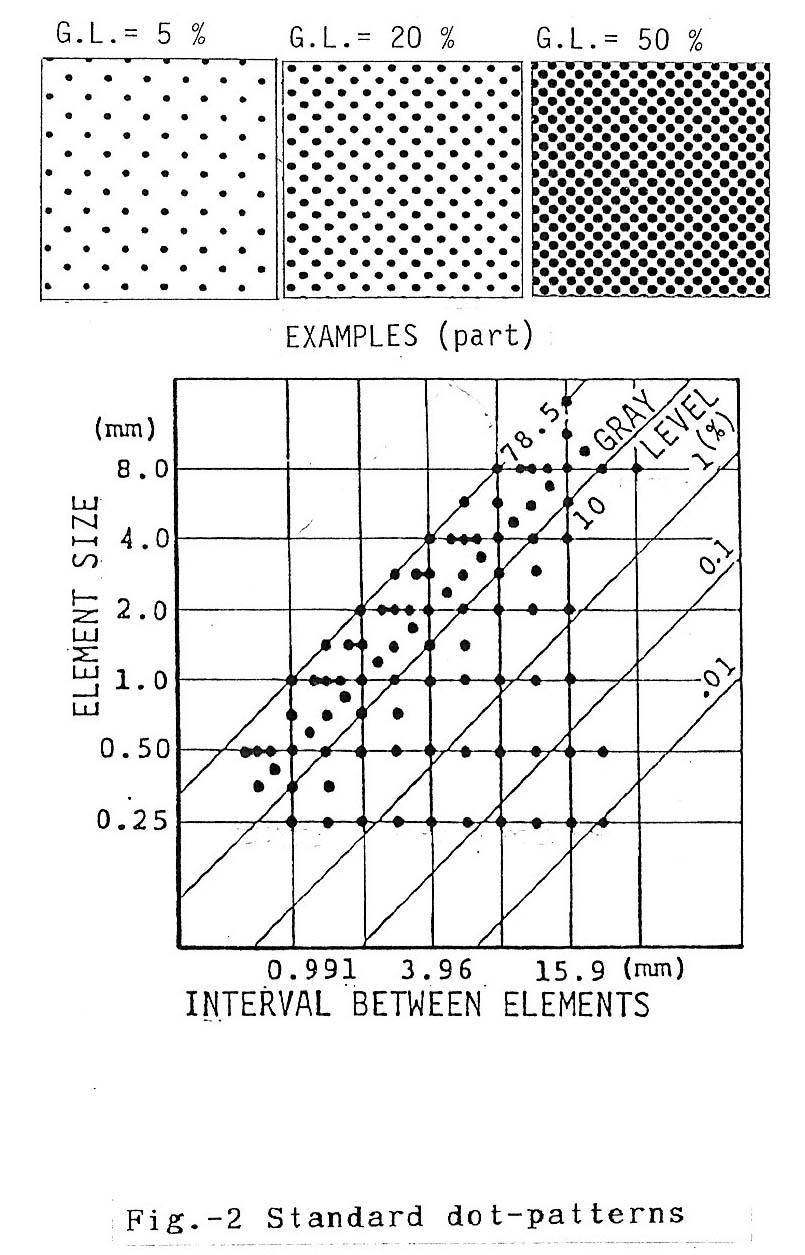 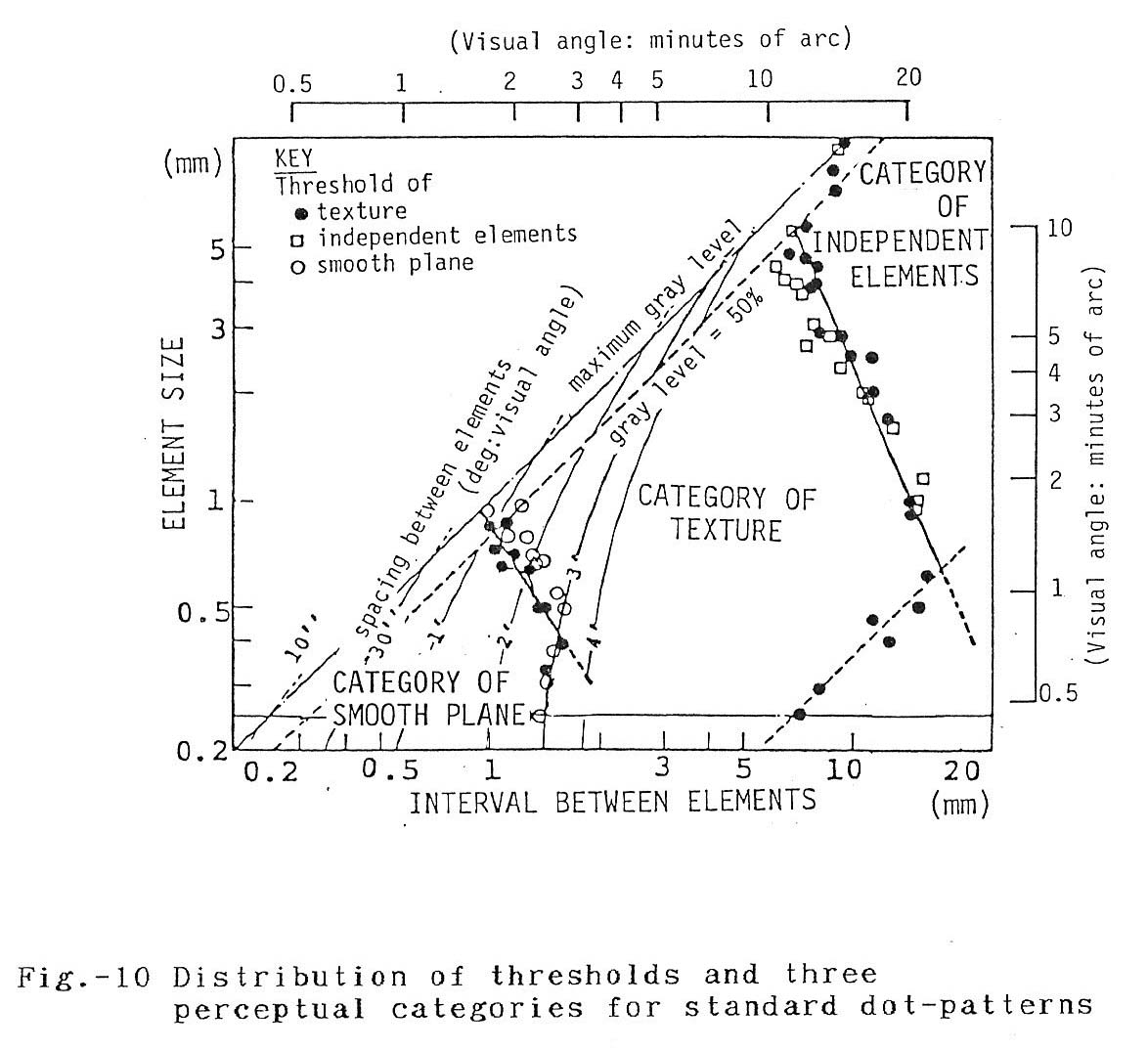
|
- The nature of texture perception in the environment, as opposed to object
perception, is discussed, and a distinction between them is empirically
made based on element size and the distribution of elements. A psychophysical
experiment using visual stimuli (dot-patterns) revealed that there is an
optimal scale range of elements to be seen as "texture". The
upper and lower limits of the category varied according to (1) the element
shape, (2) the regularity of element arrangement, (3) the brightness contrast
between element and background and (4) the size of the stimuli.
Full paper → PDF file
|
 Visual Perception of Texture: Development of a scale of the perceived surface roughness of building materials
Visual Perception of Texture: Development of a scale of the perceived surface roughness of building materials |
|
<Proceedings of the 11th Annual Conference of the Environmental Design
Research Association, pp. 193-206, Mar. 1980.>
Ryuzo Ohno
|
|
| The general question of how we can describe our experience in an environment was specified by asking how we can describe textural experience. As an initial step toward the full description of textural experience, the present paper focuses on the visual perception of surface roughness of different building materials. This study consisted of two parts: in Experiment I, 37 different finishes were judged by 20 subjects on an abbreviated semantic-differential scale. The relevance of surface roughness to the overall evaluation of texture and the effects of surface roughness on the "richness" of texture was found. In Experiment II, two different but closely related psychophysical experiments, both using textured plaster panels 12 cm x 12 cm in size as stimuli, were conducted. In the first one, a linear relationship in log-log coordinates· was found between subjective visual roughness and physical roughness. In the second one, a
linear relation between the rank score and grain size was obtained. The above two relations were combined to create a scale and a set of equations which are usable for the measurement of· apparent surface roughness.
|
Full paper → PDF file
goto TOP
|